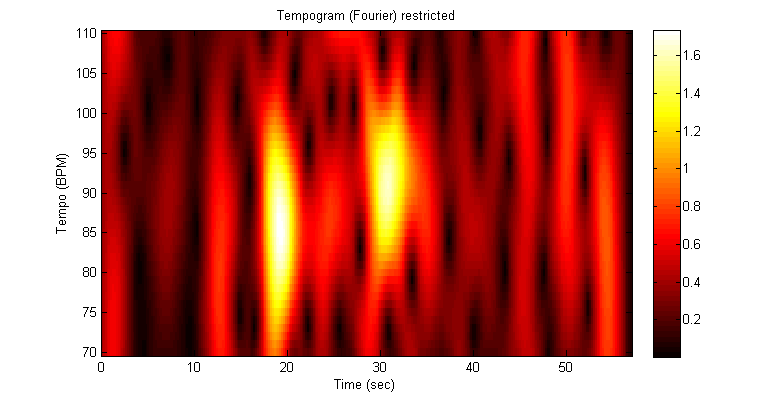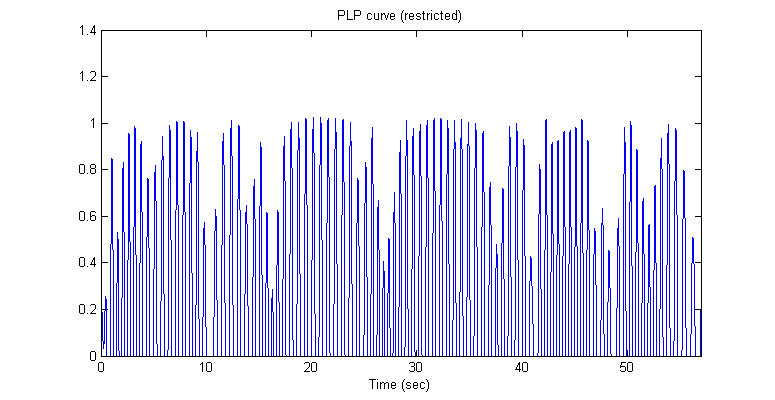Contents
%%%%%%%%%%%%%%%%%%%%%%%%%%%%%%%%%%%%%%%%%%%%%%%%%%%%%%%%%%%%%%%%%%%%%%%%%%%%%%% % Name: test_compute_PLPcurve.m % Date of Revision: 2011-10 % Programmer: Peter Grosche % http://www.mpi-inf.mpg.de/resources/MIR/tempogramtoolbox/ % % Description: Illustrates the following steps: % 1. loads a wav file % 2. computes a novelty curve % 3. computes a fourier-based tempogram % 4. derives a PLP curve % 5. visualizes novelty and PLP curves % 6. sonifies novelty and PLP peaks % 7. computes a PLP curve of a restricted tempo range % % Audio recordings are obtained from: Saarland Music Data (SMD) % http://www.mpi-inf.mpg.de/resources/SMD/ % % License: % This file is part of 'Tempogram Toolbox'. % % 'Tempogram Toolbox' is free software: you can redistribute it and/or modify % it under the terms of the GNU General Public License as published by % the Free Software Foundation, either version 2 of the License, or % (at your option) any later version. % % 'Tempogram Toolbox' is distributed in the hope that it will be % useful, % but WITHOUT ANY WARRANTY; without even the implied warranty of % MERCHANTABILITY or FITNESS FOR A PARTICULAR PURPOSE. See the % GNU General Public License for more details. % % You should have received a copy of the GNU General Public License % along with 'Tempogram Toolbox'. If not, see % <http://www.gnu.org/licenses/>. % % % Reference: % Peter Grosche and Meinard Müller % Extracting Predominant Local Pulse Information from Music Recordings % IEEE Transactions on Audio, Speech, and Language Processing, 19(6), 1688-1701, 2011. % %%%%%%%%%%%%%%%%%%%%%%%%%%%%%%%%%%%%%%%%%%%%%%%%%%%%%%%%%%%%%%%%%%%%%%%%%%% clear close all dirWav = 'data_wav/'; filename = 'Debussy_SonataViolinPianoGMinor-02_111_20080519-SMD-ss135-189.wav';
1., load wav file, automatically converted to Fs = 22050 and mono
%%%%%%%%%%%%%%%%%%%%%%%%%%%%%%%%%%%%%%%%%%%%%%%%%%%%%%%%%%%%%%%%%%%%%%%%%%% [audio,sideinfo] = wav_to_audio('',dirWav,filename); Fs = sideinfo.wav.fs;
2., compute novelty curve
%%%%%%%%%%%%%%%%%%%%%%%%%%%%%%%%%%%%%%%%%%%%%%%%%%%%%%%%%%%%%%%%%%%%%%%%%%%
parameterNovelty = [];
[noveltyCurve,featureRate] = audio_to_noveltyCurve(audio, Fs, parameterNovelty);
3., compute fourier-based tempogram
important parameters: .tempoWindow: trade-off between time- and tempo resolution try chosing a long (e.g., 12 sec) and short (e.g., 3 sec) window .BPM: tempo range and resolution
%%%%%%%%%%%%%%%%%%%%%%%%%%%%%%%%%%%%%%%%%%%%%%%%%%%%%%%%%%%%%%%%%%%%%%%%%%% parameterTempogram = []; parameterTempogram.featureRate = featureRate; parameterTempogram.tempoWindow = 6; % window length in sec parameterTempogram.BPM = 30:1:600; % tempo values [tempogram, T, BPM] = noveltyCurve_to_tempogram_via_DFT(noveltyCurve,parameterTempogram); visualize_tempogram(tempogram,T,BPM) title('Tempogram (Fourier)')
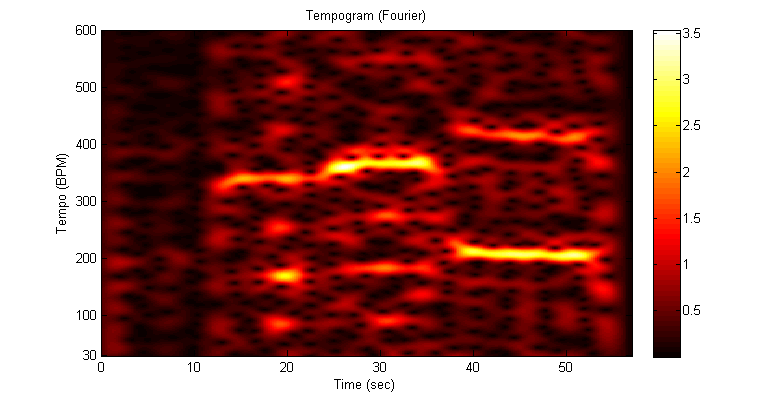
4., compute PLP curve
%%%%%%%%%%%%%%%%%%%%%%%%%%%%%%%%%%%%%%%%%%%%%%%%%%%%%%%%%%%%%%%%%%%%%%%%%%% parameterPLP = []; parameterPLP.featureRate = featureRate; parameterPLP.tempoWindow = parameterTempogram.tempoWindow; [PLP,featureRate] = tempogram_to_PLPcurve(tempogram, T, BPM, parameterPLP); PLP = PLP(1:length(noveltyCurve)); % PLP curve will be longer (zero padding)
5, visualize
%%%%%%%%%%%%%%%%%%%%%%%%%%%%%%%%%%%%%%%%%%%%%%%%%%%%%%%%%%%%%%%%%%%%%%%%%%% parameterVis = []; parameterVis.featureRate = featureRate; visualize_noveltyCurve(noveltyCurve,parameterVis) title('Novelty curve') visualize_noveltyCurve(PLP,parameterVis) title('PLP curve')
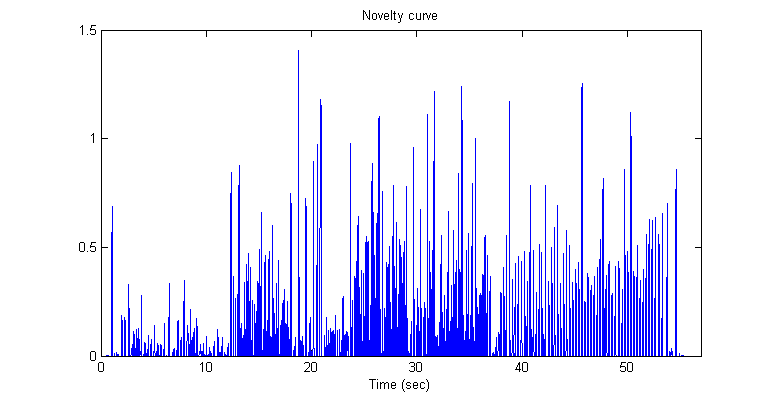
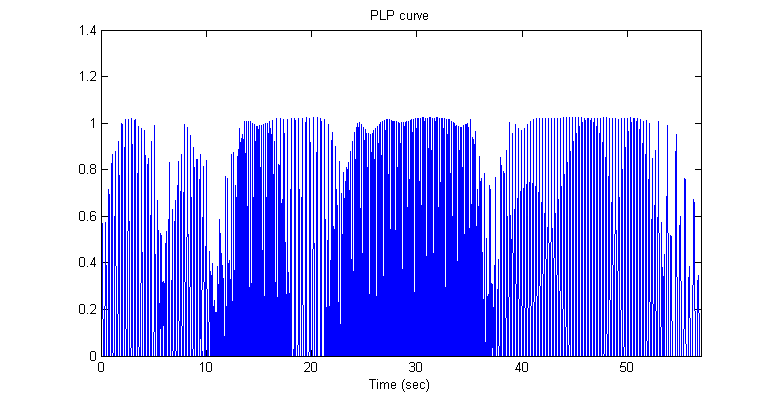
6, sonify
%%%%%%%%%%%%%%%%%%%%%%%%%%%%%%%%%%%%%%%%%%%%%%%%%%%%%%%%%%%%%%%%%%%%%%%%%%% parameterSoni = []; parameterSoni.Fs = Fs; parameterSoni.featureRate = featureRate; sonification = sonify_noveltyCurve(noveltyCurve,audio,parameterSoni); wavwrite(sonification,Fs,'sonification_novelty.wav') parameterSoni = []; parameterSoni.Fs = Fs; parameterSoni.featureRate = featureRate; sonification = sonify_noveltyCurve(PLP,audio,parameterSoni); wavwrite(sonification,Fs,'sonification_PLP.wav')
7, compute a PLP curve of a restricted tempo range
Here, we restrict the range of tempo parameters to [70,110] BPM and compute a restricted PLP curve.
Instead of computing a restricted tempogram, we could also set parameterPLP.PLPrange = [70,110] and use the original tempogram with the tempo set [30,600]
%%%%%%%%%%%%%%%%%%%%%%%%%%%%%%%%%%%%%%%%%%%%%%%%%%%%%%%%%%%%%%%%%%%%%%%%%%% parameterTempogram.tempoWindow = 6; % window length in sec parameterTempogram.BPM = 70:1:110; % tempo values [tempogram, T, BPM] = noveltyCurve_to_tempogram_via_DFT(noveltyCurve,parameterTempogram); visualize_tempogram(tempogram,T,BPM) title('Tempogram (Fourier) restricted') parameterPLP.tempoWindow = parameterTempogram.tempoWindow; [PLP_restricted] = tempogram_to_PLPcurve(tempogram, T, BPM, parameterPLP); PLP_restricted = PLP_restricted(1:length(noveltyCurve)); % PLP curve will be longer (zero padding) visualize_noveltyCurve(PLP_restricted,parameterVis) title('PLP curve (restricted)') sonification = sonify_noveltyCurve(PLP_restricted,audio,parameterSoni); wavwrite(sonification,Fs,'sonification_PLP-BPMrestricted.wav')
